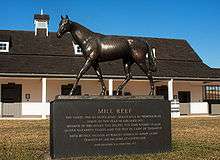John Skeaping
John Rattenbury Skeaping, R.A. (9 June 1901 – 5 March 1980) was an English sculptor and equine painter and sculptor. He designed animal figures for Wedgwood.

Biography

Born in South Woodford, Essex, Skeaping was the son of the painter Kenneth Mathieson Skeaping and studied at Goldsmith's College in London, the Central School of Arts and Crafts between 1917 and 1919 and later at the Royal Academy until 1920.[1][2] In 1924 he won the British Prix de Rome and its scholarship to the British School at Rome.̣[1]
Skeaping was the first husband of the sculptor Barbara Hepworth, whom he met while studying in Rome.[2] The couple had a joint exhibition in 1928 at the Alex Reid and Lefevre Gallery in Glasgow.[2] They married in 1924 but the marriage was dissolved in 1933.[1] He was a member of the London Group from 1928 to 1934, joined the Seven and Five Society in 1932 and later, after World War II, worked for a period in Mexico.[1][2] During the War, Skeaping had been commissioned by the War Artists' Advisory Committee to produce a portrait bust.[3][4] He was elected to the Royal Academy in 1960, having exhibited there since 1922.[1] Skeaping wrote several books on drawing and an authobiography, Drawn from Life was published in 1977.[1] From 1948, he taught sculpture at the Royal College of Art and was professor of sculpture there from 1953 to 1959.[1][2]
Skeaping latterly lived in Devon near the village of Chagford and moved to the Camargue, France in 1959. A BBC documentary One Pair of Eyes - John Skeaping (1970) directed by David Cobham was produced for BBC TV during Skeaping's time there.[5] The Tate Gallery owns eight works by Skeaping.[6]
Portrait sculptures
Marble heads dating from London, c. 1927[7] of Barbara Hepworth by Skeaping, and of Skeaping by Hepworth are documented by photograph in the Retrospective catalogue, but are both believed lost. A stone head of Arthur Lett-Haines dates from 1933, when Skeaping was living in the artists' colony at the house of Sir Cedric Morris after the breakup of his marriage to Hepworth. A bronze sketch (1978)[8] of Skeaping exists by Sally Arnup.
Animals for Wedgwood
.jpg) Fawn
Fawn.jpg) Monkeys
Monkeys.jpg) Bison
Bison.jpg) Polar bear
Polar bear
References
- David Buckman (2006). Artists in Britain Since 1945 Vol 2, M to Z. Art Dictionaries Ltd. ISBN 0 953260 95 X.
- Frances Spalding (1990). 20th Century Painters and Sculptors. Antique Collectors' Club. ISBN 1 85149 106 6.
- Brian Foss (2007). War Paint: Art, War, State and Identity in Britain, 1939-1945. Yale University Press. ISBN 978-0-300-10890-3.
- Imperial War Museum. "War artists archive, John Skeaping". Imperial War Museum. Retrieved 31 March 2020.
- http://ftvdb.bfi.org.uk/sift/title/97967
- http://www.tate.org.uk/servlet/ArtistWorks?cgroupid=999999961&artistid=1949&page=1
- John Skeaping 1901-80: A Retrospective, exh. cat., Arthur Ackermann and Son, London, 1991 p. 7.
- John Skeaping 1901-80: A Retrospective, exh. cat., Arthur Ackermann and Son, London, 1991 p. 67.
Further reading
- 2011: The Sculpture of John Skeaping, Jonathan Blackwood (Lund Humphries); ISBN 978-0-85331-931-3
External links
| Wikimedia Commons has media related to John Skeaping. |
- 1 painting by or after John Skeaping at the Art UK site